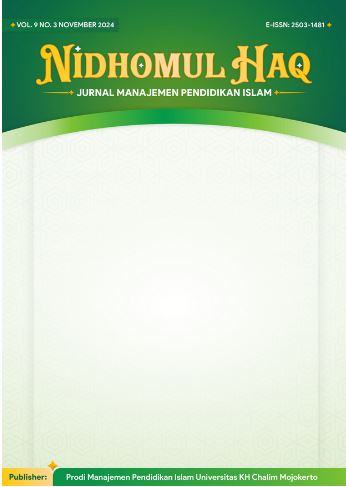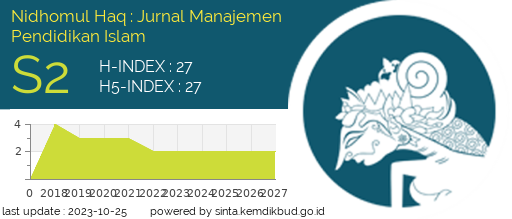Teacher Strategies in Preventing Verbal and Physical Violence at the Educational Unit Level
DOI:
https://doi.org/10.31538/ndhq.v10i1.54Keywords:
Strategy, teacher, prevention, violence, educational unitAbstract
Violence in educational units is a crucial issue that negatively impacts the psychological and academic development of students. Teachers play a strategic role in preventing and addressing violence within the school environment. This study aims to identify strategies that can be implemented by teachers to prevent violence in educational units. The research employs a qualitative approach with data collected through interviews, observations, and literature reviews. This study highlights the importance of enhancing teachers' capacities through more comprehensive training so that they can become agents of change in creating a safe and inclusive educational environment. The findings indicate that violence prevention strategies can be implemented through three main approaches, namely: Preventive Approach: Involves the implementation of character education, the creation of a positive school culture, and effective communication among teachers, students, and parents. Intervention Approach: Involves the early detection of potential violence, the engagement of school counselors, and the use of technology in monitoring student behavior. Rehabilitative Approach: Involves providing psychosocial support for both victims and perpetrators, as well as recovery programs based on inclusiveness. With active teacher involvement in preventing violence, it is expected that the incidence of violence will decrease, allowing students to develop optimally within a positive learning environment. This study recommends strengthening teachers' capacities in pedagogical, psychological, and social aspects so that they can serve as effective agents of change in creating a safe and comfortable educational environment.
References
Agustin, M., Saripah, I., & Gustiana, A. D. (2018). Analisis Tipikal Kekerasan Pada Anak Dan Faktor Yang Melatarbelakanginya. JIV-Jurnal Ilmiah Visi, 13(1), 1–10. https://doi.org/10.21009/jiv.1301.1
Arif, M. (2023). Pentingnya Pencegahan Tindakan Kekerasan di Sekolah. Universitas Brawijaya.
Bauman, S., Rigby, K., & Hoppa, K. (2008). Principles of effective anti-bullying programs. Educational Psychology, 28(5), 537–556.
Bradshaw, C. P., Sawyer, A. L., & O’Brennan, L. M. (2007). Bullying and peer victimization at school: Perceptual differences between students and school staff. School Psychology Review, 36(3), 361–382.
Cornell, D. G., & Mayer, M. J. (2010). Why do school anti-bullying programs fail? Education Researcher, 39(1), 27–37.
Cross, D., Lester, L., & Barnes, A. (2016). A longitudinal study of the social and emotional predictors of cyber and traditional bullying involvement. International Journal of Public Health, 61(1), 1–10.
Dessel, A. B. (2010). Prejudice in schools: Promoting tolerance and acceptance. Child & Youth Services, 32(3), 2010.
Espelage, D. L., Hong, J. S., Rao, M. A., & Thornberg, R. (2016). Understanding ecological processes associated with bullying and peer victimization. Journal of School Psychology, 56, 1–4.
Espelage, D. L., Low, S., Polanin, J. R., & Brown, E. C. (2020). Clinical trial of Second Step middle school program: Impact on bullying, cyberbullying, homophobic teasing, and sexual harassment perpetration. School Psychology Review, 49(2), 222–238. https://doi.org/https://doi.org/10.1080/2372966X.2020.1725467
Gaffney, H., Farrington, D. P., & Ttofi, M. M. (2021). Examining the effectiveness of school-bullying intervention programs globally: A meta-analysis. International Journal of Bullying Prevention, 3(2), 105–123. https://doi.org/105–123. https://doi.org/10.1007/s42380-020-00078-y
Girsang, C. M. (2023). Upaya Baru dalam Pencegahan dan Penanganan Kekerasan di Sekolah. Universitas Muhammadiyah Jakarta.
Hinduja, S., & Patchin, J. W. (2020). Connecting adolescent suicide to the severity of bullying and cyberbullying. Journal of School Violence, 19(4), 1–14. https://doi.org/https://doi.org/10.1080/15388220.2020.1725539
Kärnä, A., Voeten, M., Little, T. D., Poskiparta, E., Kaljonen, A., & Salmivalli, C. (2011). A large-scale evaluation of the KiVa antibullying program: Grades 4-6. Child Development, 82(1), 311-330.
Kaufman, T. M. L., Kretschmer, T., Huitsing, G., & Veenstra, R. (2020). Why does a universal anti-bullying program not help all children? Explaining persistent victimization during an intervention. Prevention Science, 21(5), 680–693. https://doi.org/https://doi.org/10.1007/s11121-020-01113-y
Lester, L., Cross, D., Dooley, J., & Shaw, T. (2020). Bullying victimisation and adolescents: Implications for school-based intervention programs. Australian Journal of Education, 64(1), 73–90. https://doi.org/https://doi.org/10.1177/0004944119890138
Migliaccio, T., & Raskauskas, J. (2020). Bullying as a social experience: Social factors, prevention and intervention. Routledge. https://doi.org/https://doi.org/10.4324/9780429453126
Mulya, A. P., Sujatmiko, B., & Kurniawan, S. M. (2023). Edukasi Pencegahan Bullying pada Anak Sekolah Dasar di Kabupaten Bandung. International Journal of Research in Science Commerce, Arts, Management and Technology, 6, 410–421. https://doi.org/https://doi.org/10.48175/ijarsct-13062
Noer, K. U., Hanafi, A., Khairunnisa, D. A., & Putri, F. D. (2021). Sekolah Ramah Anak, Disiplin, Dan Budaya Kekerasan Di Sekolah Di Indonesia. Kafa`ah: Journal of Gender Studies, 11(1), 55. https://doi.org/10.15548/jk.v11i1.393
Nurhanifa, A., & Lestari, S. (2020). ). Pengaruh Penggunaan Media Sosial terhadap Perilaku Bullying pada Remaja. Jurnal Psikologi Udayana, 17(2), 123–135.
Olweus, D., & Limber, S. P. (2021). Bullying in school: Evaluation and dissemination of the Olweus Bullying Prevention Program. American Journal of Orthopsychiatry, 91(2), 291–302. https://doi.org/https://doi.org/10.1037/ort0000531
Olweus, D. (2013). School bullying: Development and some important challenges. Annual Review of Clinical Psychology, 9, 751–780.
Patton. (2011). Purposeful Sampling in Qualitative Research Synthesis. Qualitative Research Journal, 11(2), 63–75.
Pouwels, J. L., Lansu, T. A. M., & Cillessen, A. H. N. (2020). A developmental perspective on popularity and the group process of bullying. Aggression and Violent Behavior, 51, 101379. https://doi.org/https://doi.org/10.1016/j.avb.2020.101379
Priangan Insider. (2024). Antisipasi Tradisi Kekerasan di Sekolah, Tumbuhkan Lingkungan Belajar yang Aman dan Nyaman.
Rahman, A., & Salamah, U. (2023). Pemahaman Anak dan Orang Tua terhadap Kekerasan Berbasis Elektronik. Jurnal Pendidikan Glasser, 7(2), 123–135.
Rigby, K. (2012). The Dynamics of School Violence and Teachers’ Perceptions: A Case Study. Australian Journal of Education, 56(4), 367-382.
Salmivalli, C., Kärnä, A., & Poskiparta, E. (2021). From peer putdowns to peer support: A theoretical model and how it translated into a national anti-bullying program. In P. K. Smith & J. O’Higgins Norman (Eds.), The Wiley Blackwell handbook of bullying: A comprehensive and international review of researc. The Wiley Blackwell Handbook of Bullying: A Comprehensive and International Review of Research and Intervention, 2, 361–375. https://doi.org/https://doi.org/10.1002/9781118482650.ch18
SMA Wachid Hasyim 2 Taman. (2023). Strategi Sekolah dalam Pencegahan dan Penanganan Kekerasan.
Smith, P. K., & O’Higgins Norman, J. (Eds. ). (2021). The Wiley Blackwell handbook of bullying A comprehensive and international review of research and intervention. Wiley Blackwell, 1–2. https://doi.org/https://doi.org/10.1002/9781118482650
Smith, P. K., & Sharp, S. (1994). School bullying: Insights and perspectives. In Routledge.: Vol. (Issue).
Swearer, S. M., Espelage, D. L., Vaillancourt, T., & Hymel, S. (2010). Bullying prevention and intervention: Realistic strategies for schools. Educational Psychology, 45(4), 37–53.
Thornberg, R., Wänström, L., & Pozzoli, T. (2020). Peer victimization and its relation to class relational climate and class moral disengagement among school children. Educational Psychology, 40(4), 458–478. https://doi.org/https://doi.org/10.1080/01443410.2019.1674170
Ttofi, M. M., & Farrington, D. P. (2011). Effectiveness of School Violence Prevention Programs: A Meta-Analytic Review. Journal of Experimental Criminology, 7(1), 27–56.
Ttofi, M. M., & Farrington, D. P. (2020). School bullying: Risk factors, theories, and interventions. In B. B. R. G. M. van der Bosch & P. K. Smith (Eds.), The Wiley Blackwell handbook of bullying: A comprehensive and international review of research and intervention. Wiley Blackwell, 1, 153–173. https://doi.org/https://doi.org/10.1002/9781118482650.ch8
UNESCO. (2019). Global Report on Violence in Schools.
van Geel, M., Vedder, P., & Tanilon, J. (2020). Are overweight and obese youths more often bullied by their peers? A meta-analysis on the relation between weight status and bullying. International Journal of Obesity, 38(10), 1263–1267. https://doi.org/https://doi.org/10.1038/ijo.2014.117
Williford, A., Boulton, A. J., Noland, B. L., Little, T. D., & Salmivalli, C. (2013). Peer and teacher relationships as predictors of cyberbullying involvement. Journal of Youth and Adolescence, 42(5), 711–722.
Wolke, D., & Lereya, S. T. (2020). Long-term effects of bullying. Archives of Disease in Childhood, 100(9), 879–885. https://doi.org/10.1136/archdischild-2014-306667
Yuni, M., & Melani, R. (2020). Aplikasi Pelaporan Tindakan Kekerasan terhadap Perempuan dan Anak Berbasis Android. Jurnal Teknologi Informasi Dan Komunikasi, 5(1), 15–25.
Zahara Tusssoleha Rony, Khairil Anwar, Muhammad Nur, Suyitno, N. S. (2024). Improving Teacher Performance Through Total Quality Managementand Academic Supervision. Nidhomul Haq: Jurnal Manajemen Pendidikan Islam, 9(2), 429–442.
Zahriyanti, Z. (2022). Strategi Sekolah dalam Pencegahan dan Penanggulangan Tindakan Kekerasan Bullying Menurut Perspektif Pendidikan Islam (Studi Penelitian pada SMA Negeri di Kabupaten Bireuen). Universitas Islam Negeri Ar-Raniry.
Zych, I., Farrington, D. P., & Ttofi, M. M. (2020). Protective factors against bullying and cyberbullying: A systematic review of meta-analyse. Aggression and Violent Behavior, 45(4), 4–19. https://doi.org/https://doi.org/10.1016/j.avb.2018.06.008
Downloads
Published
How to Cite
Issue
Section
License
Copyright (c) 2025 yati, Ojat Darojat, Fitra Jaya, Sucipto, Romi Siswanto, Kadarisman

This work is licensed under a Creative Commons Attribution-ShareAlike 4.0 International License.






